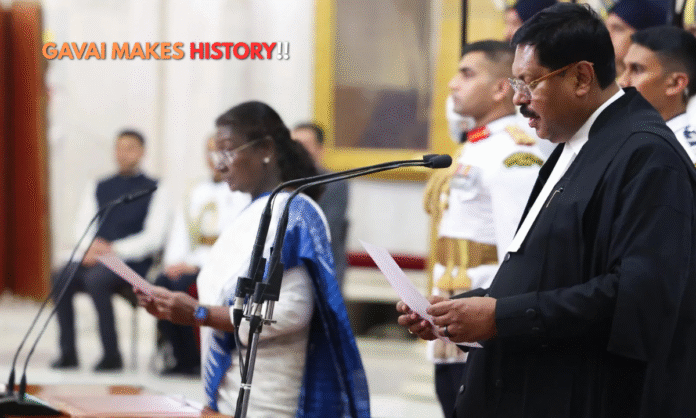Summary
- Justice B.R. Gavai is the first Buddhist and only the second Scheduled Caste judge to become Chief Justice of India.
- He has authored 300+ judgments and sat on 700 benches, including verdicts on Article 370, demonetisation, and electoral bonds.
- Gavai’s appointment is widely seen as a landmark moment for inclusivity and judicial legacy.
Symbol and Substance: Justice Gavai’s Historic Elevation to the Top Bench
India’s judiciary marked a watershed moment on May 15, 2025, when Justice Bhushan Ramkrishna Gavai took oath as the 52nd Chief Justice of India (CJI). A man of profound legal experience and quiet perseverance, Justice Gavai’s elevation is not just a matter of seniority—it is a moment thick with symbolic weight.
He is the first Buddhist and only the second judge from the Scheduled Castes to ascend to the country’s highest judicial office. The milestone is being hailed as a long-overdue nod to India’s constitutional promise of representation, diversity, and equality under the law.
But this is not just about background—it is about jurisprudence. Justice Gavai’s record speaks volumes. With over 300 judgments to his name and participation in around 700 benches over six years in the Supreme Court, his legacy is one of quiet diligence and balanced interpretation of the Constitution.
As he assumes office, Justice Gavai brings to the top court not only a lens shaped by the lived experience of marginalisation but also a deep commitment to constitutional morality—a concept his tenure is expected to echo repeatedly.
Justice BR Gavai Sworn In As 52nd Chief Justice Of India; First Buddhist, Second Dalit CJI | @LiveLawIndia pic.twitter.com/7o3VIw6bJD
— Hemprasad Jagat (@hemprasad_J) May 14, 2025
The Legacy So Far: Verdicts that Defined Justice Gavai
- Part of the Constitution Bench that upheld Article 370 abrogation.
- Delivered the judgment striking down the electoral bonds scheme.
- Upheld the Centre’s 2016 demonetisation move as constitutionally valid.
- Presided over the bench that stayed Rahul Gandhi’s defamation conviction.
- Granted bail to Teesta Setalvad and AAP leader Manish Sisodia.
Justice Gavai’s name may not always have grabbed headlines, but his judgments have consistently shaped India’s legal and political landscape. As part of landmark constitutional benches, he played a pivotal role in decisions that reaffirmed executive actions—some controversial, others widely debated.
In the Article 370 verdict, he sided with the Centre’s position, stating that the special status granted to Jammu and Kashmir was always meant to be temporary. In doing so, his bench underlined the supremacy of the Parliament in constitutional re-engineering.
His judgment striking down the opaque electoral bonds scheme was hailed as a bold stand for transparency, reasserting the citizen’s right to informed electoral choice. On demonetisation, however, he ruled in favour of the Centre, a decision that continues to polarize economists and legal scholars alike.
Justice Gavai has also extended relief in high-stakes political and civil liberty cases—granting bail to Manish Sisodia in the liquor scam, Teesta Setalvad in the Gujarat riots-linked case, and Rahul Gandhi in the Modi surname defamation case. These rulings, taken together, portray a jurist committed to individual freedoms within the constitutional framework.
Quiet Reformer: Career Path Rooted in Regional Depth
- Born in Amravati, Maharashtra, in 1960; began practicing law in 1985.
- Rose from a Public Prosecutor at Nagpur Bench to Supreme Court judge in 2019.
- Served across Mumbai, Nagpur, Aurangabad, and Panaji benches of Bombay High Court.
- Known for his expertise in constitutional, environmental, and criminal law.
- Authored judgments across key sectors, from education to arbitration.
Justice Gavai’s journey from the Vidarbha heartland to the Chief Justice’s chambers at Tilak Marg reflects a rise rooted in legal merit rather than elite pedigree. Unlike many top-tier judges from national capital circuits or English-speaking metropolitan schools, Gavai’s path cut through regional benches and grassroots litigations.
He served as Standing Counsel for local municipalities and universities before being appointed Additional Judge of the Bombay High Court in 2003. Over the years, he developed a reputation for balanced jurisprudence, especially in criminal law, administrative issues, and environmental regulation.
His familiarity with pan-India judicial cultures—from rural Maharashtra to Goa—gives him a unique sensitivity to how justice is experienced differently across India. This regional immersion might inform a more grounded approach during his tenure as CJI.
What Gavai’s Tenure Could Mean for India’s Judiciary
- His term ends in November 2025—short, but crucial as pending constitutional matters loom.
- May steer the court through debates on caste census, electoral reforms, and digital surveillance.
- Expected to focus on access to justice and institutional diversity.
- His symbolic elevation may inspire confidence in historically excluded communities.
Justice Gavai’s tenure may be brief—just over six months—but it arrives at a time when the judiciary is facing pivotal tests: pending cases on caste census legality, the electoral process, and the expanding reach of state surveillance require calm yet firm constitutional stewardship.
Insiders believe Gavai will prioritize institutional reform from within, including increasing transparency in case listing and promoting judicial inclusivity at the High Court level. He is also expected to signal the importance of access to justice for socially and economically marginalised litigants.
His symbolic elevation may also influence how India’s legal system is perceived by its most disenfranchised communities. In a judiciary often critiqued for being upper-caste dominated, Gavai’s rise is not merely ceremonial—it is psychological reassurance.
Beyond the Gavel: A Moment of Justice for Justice
Justice Gavai’s appointment is not just about another gavel-holder in the Supreme Court. It’s a moment of historical vindication—for communities long absent from the corridors of judicial power, and for constitutionalists who believe that representation matters just as much as interpretation.
As India navigates its complex democratic future, Justice Gavai’s legacy may well be measured not just in rulings but in the quiet conviction that the highest bench of the land can—and must—look like the people it serves.


